

Ben Zachariah
CarExpert's top five EV reviews of 2025
2 Hours Ago
If you like the look of the Peugeot 3008 but want some extra practicality, the 5008 packs a couple of extra seats but no less flair.
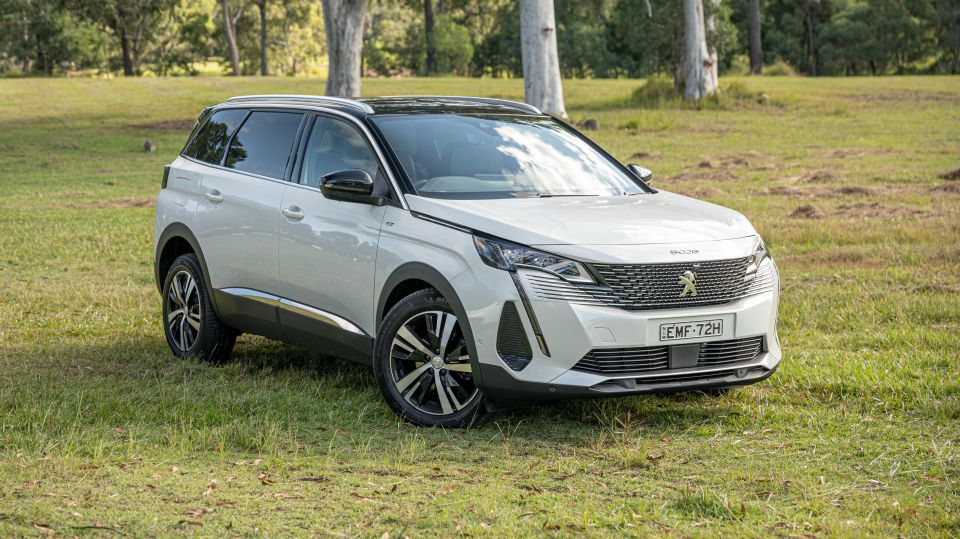
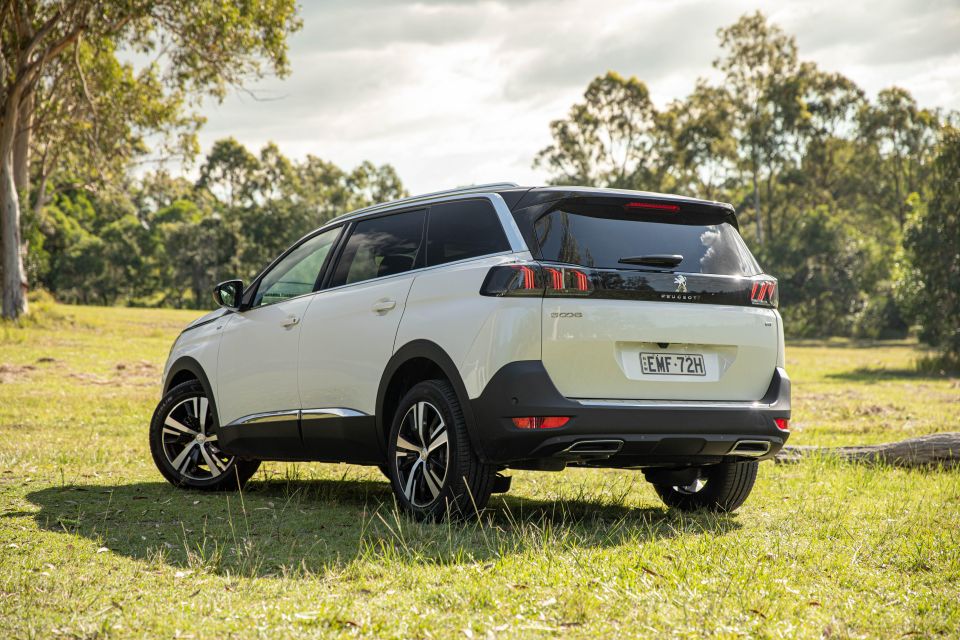

News Editor
New from
$51,990
excl. on-roads

News Editor
New from
$51,990
excl. on-roads


News Editor
New from
$51,990
excl. on-roads

News Editor
New from
$51,990
excl. on-roads
Quickly see how this car stacks up against its competition. Select any benchmark to see more details.
Where expert car reviews meet expert car buying – CarExpert gives you trusted advice, personalised service and real savings on your next new car.
While the 3008 may be Peugeot’s best-seller in Australia, it has a more practical sibling in the Peugeot 5008.
If you haven’t heard of the 3008 and 5008, think of them as Peugeot’s equivalent to the Mazda CX-5 and CX-8, respectively, or the Volkswagen Tiguan and Tiguan Allspace.
The original 3008 and 5008 have morphed from quasi-MPVs in their first generations to today’s handsome, high-riding crossovers.
They’re essentially identical from the B-pillar forward and, while rear details like tail lights are similar on both, the two models deviate considerably in shape.

To accommodate a third row, the 5008 has a boxier silhouette, a 165mm longer wheelbase, and a more upright tailgate.
For 2021, both the 3008 and 5008 received a facelift that brought a new grille and plunging, fang-like LED daytime running lights and indicators. These also include a Fog Mode, which replaces conventional fog lights.
The rear received some more subtle revisions, with the tail lights now entirely LED and featuring dynamic indicators.
Though Peugeot recently revealed a new crest logo, the redesigned 2008 and refreshed 3008 and 5008 all feature the previous logo. The walking lion looks fabulous in the new frameless grille, though the awkward positioning of the front camera indicates why Peugeot may have wanted to change to a more conventional badge shape.
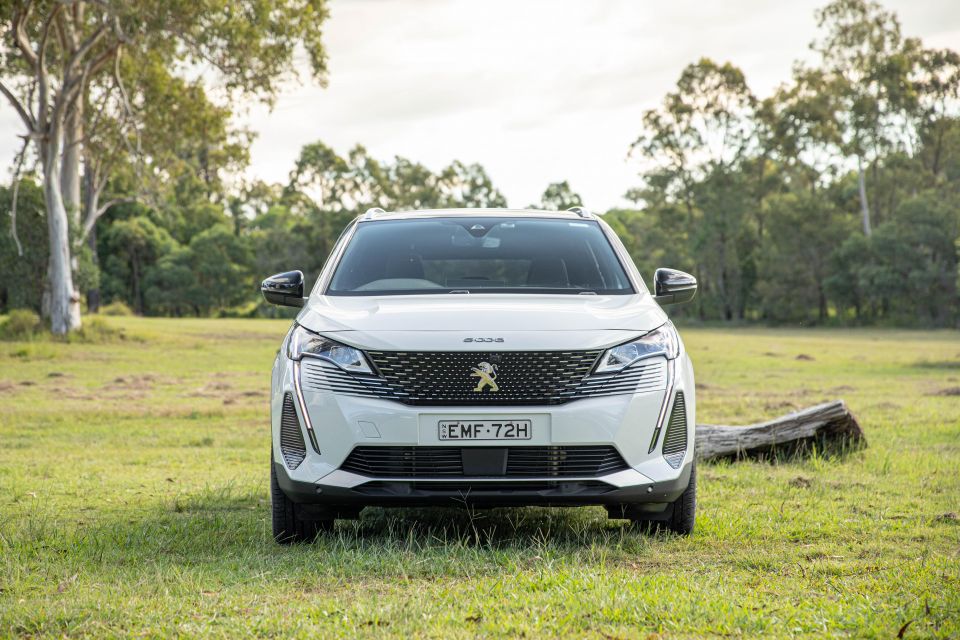
The 5008 has a small, two-model range, albeit with a confusing twist.
Both models are badged GT but feature different powertrains, with the diesel GT also offering numerous extra features.
The 2021 Peugeot 5008 GT petrol costs $51,990 before on-road costs, while the GT diesel is $59,990 before on-roads. Neither variant is available with all-wheel drive, which means front-wheel drive is mandatory.
Our GT petrol model came with a $3590 option pack and the $1990 panoramic sunroof.
The only other option is premium paint, which costs either $690 or $1050 depending on shade. Our tester’s Pearl White shade costs $1050, with only Sunset Copper not costing extra.
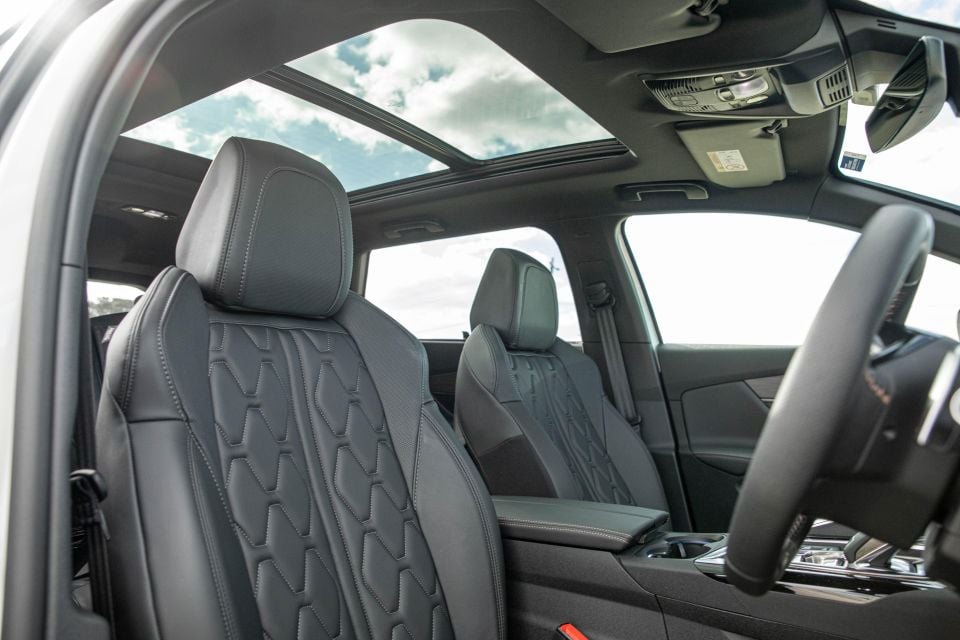
Without any of these option boxes ticked, you’re looking at $56,642 drive-away for a 5008 GT petrol, based on a Sydney postcode. As tested, you’re looking at around $63,623 drive-away.
The GT petrol’s price puts it against the likes of the Volkswagen Tiguan Allspace, of which an updated version is coming in the first quarter of 2022. The outgoing model is currently priced at $53,190 before on-roads in 162TSI Highline guise.
An updated Skoda Kodiaq is due in December 2021, and the current 132TSI Sportline is priced at $50,290 before on-roads. There’s also the recently-revised Mazda CX-8, which costs $53,790 before on-roads in Touring diesel guise.
There are other seven-seaters at the base 5008 price point, though they’re typically larger models with lower specification levels.
These include the Hyundai Santa Fe in all-wheel drive, diesel Active trim and front-wheel drive Elite V6 trim ($51,800 and $54,300 before on-roads), plus the front-wheel drive Kia Sorento Sport+ V6 ($56,690 drive-away).
The 5008 is even knocking on the door of the Mercedes-Benz GLB, another European seven-seater. It’s priced at $60,200 before on-road costs.

Buy your new car without the stress. It's fast, simple and completely free.

Great service from Travis and team, second time I have used this business would not hesitate to recommend them to anyone
Craig C.
Purchased a Ford Ranger in Sunshine Coast, QLD
CarExpert helped Craig save thousands on his Ford Ranger, now let us save you on your next new car.
Find a dealThe GT petrol comes standard with the following features:
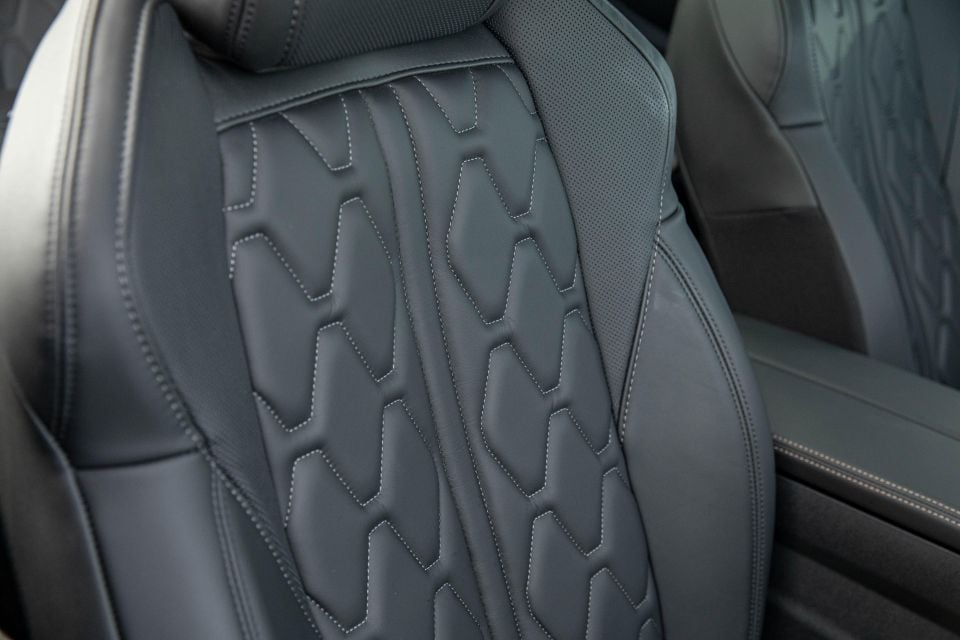
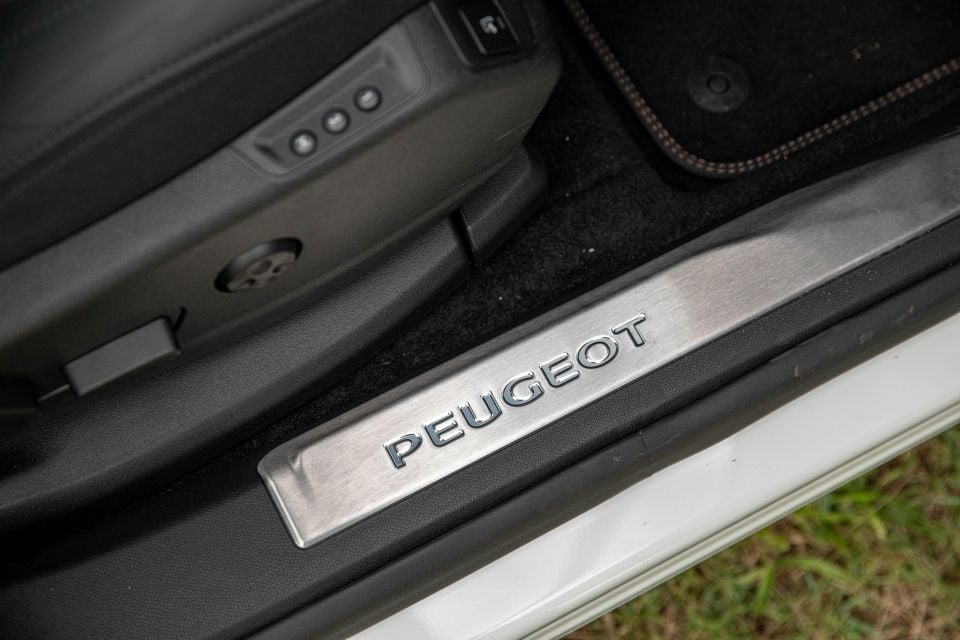
The $3590 option pack adds:
The GT diesel adds the items from the option pack bar the Nappa leather upholstery, which is a $2590 option.
The oil-burner also picks up a 515W 10-speaker Focal premium sound system and 19-inch alloy wheels, though it swaps the petrol model’s space-saver spare for a tyre repair kit.
Even without the option package, the GT petrol’s equipment list is superior to that of the pricier CX-8 Touring which lacks a power tailgate and wireless phone charging. Skoda also puts semi-autonomous parking assist, blind-spot monitoring and rear cross-traffic alert into an option package with its Kodiaq.
The Tiguan Allspace 162TSI Highline is $1200 more expensive than the standard 5008 GT petrol but includes standard kit like adaptive suspension and heated front and rear seats.
While the 5008 GT is only front-wheel drive and has a less powerful engine than the likes of the Tiguan, in terms of standard equipment it stacks up well against key rivals.
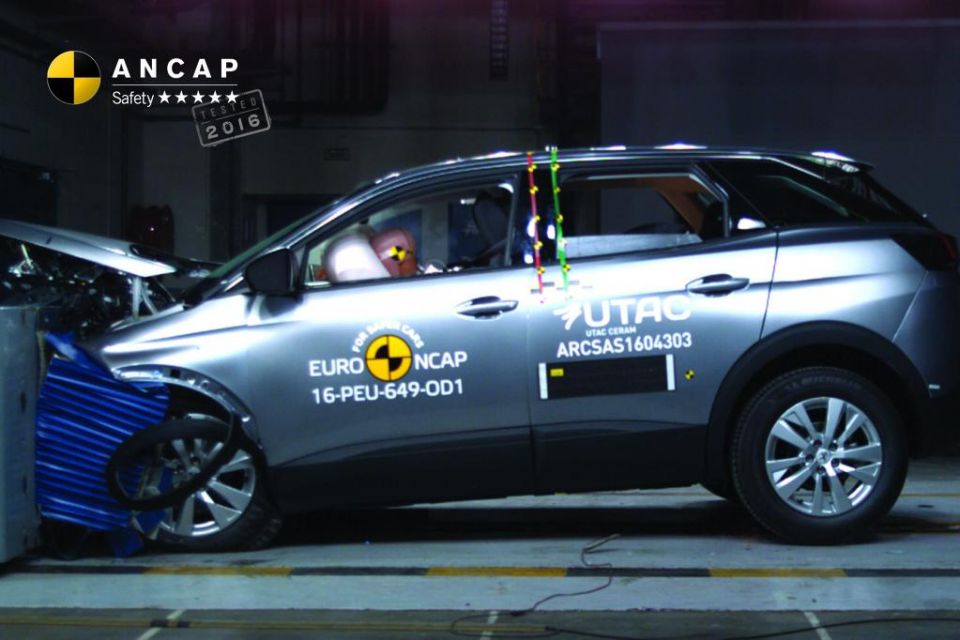
The 5008 has a five-star rating from ANCAP based on tests conducted by Euro NCAP in 2016 on the related 3008.
It received an adult occupant protection score of 86 per cent, child occupant protection of 85 per cent, pedestrian protection of 67 per cent and safety assist of 58 per cent.
Standard safety equipment across the range includes:
The GT diesel adds lane-positioning assist.
The autonomous emergency braking system works at speeds of up to 60km/h for pedestrians, up to 80km/h for stationary vehicles or cyclists, and up to 140km/h for moving vehicles.
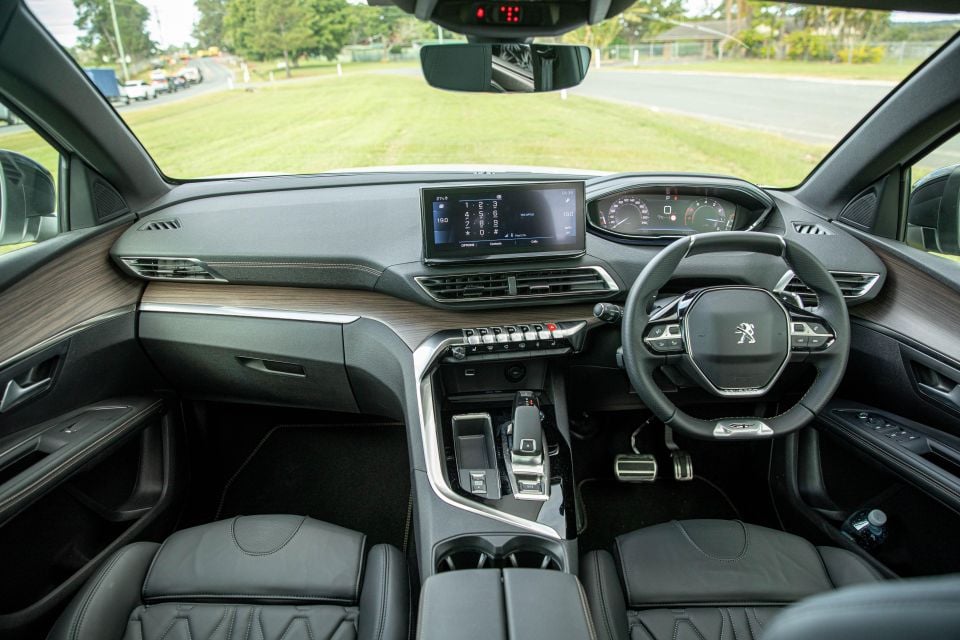
Much as the exterior of the 5008 is largely identical to the 3008 from the C-pillar forward, so too is the interior.
You still have the same dramatic dashboard with a low-mounted, small steering wheel and a high-mounted digital instrument cluster. The cabin is bathed in soft blue ambient lighting, while GT models with the option package feature wood trim on the dash and doors plus seats swathed in supple Nappa leather.
There’s an angular centre stack, with two rows of switches below the touchscreen with a wireless charger, a USB-A port and 12V outlet. The centre console features a slick, pistol grip-style gear shifter and switches for the electronic park brake and drive mode selector.

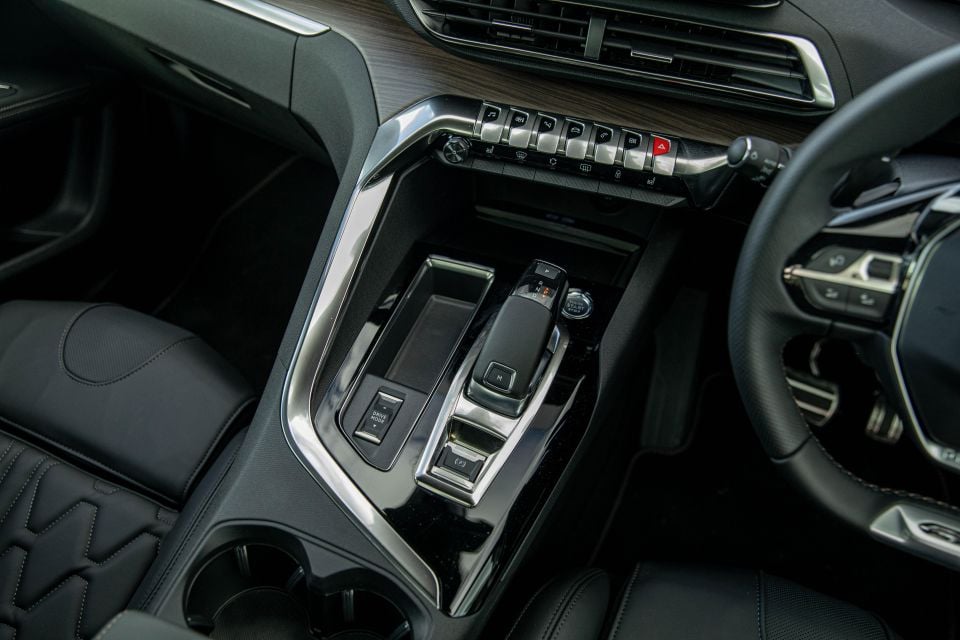
Material quality is superb, with the dashboard, doors, and most of the centre console finished in soft-touch plastics. There are hard plastics used on the lower reaches of the dash and doors but the graining is virtually indistinguishable from that of the soft stuff.
There are other high-quality touches, like front door pockets lined in felt and an extremely soft centre console bin lid.
The row of metal-look toggle switches are attractive and give the centre stack a minimalist look, but Peugeot has gone too far in eliminating switchgear. There are no conventional climate controls, with everything done via the touchscreen.
Peugeot has helpfully included shortcut buttons on the side of each menu screen, which also remain present when you’re using smartphone mirroring, but it’s still a lot clunkier to use than just twisting a knob or pressing a hard button.
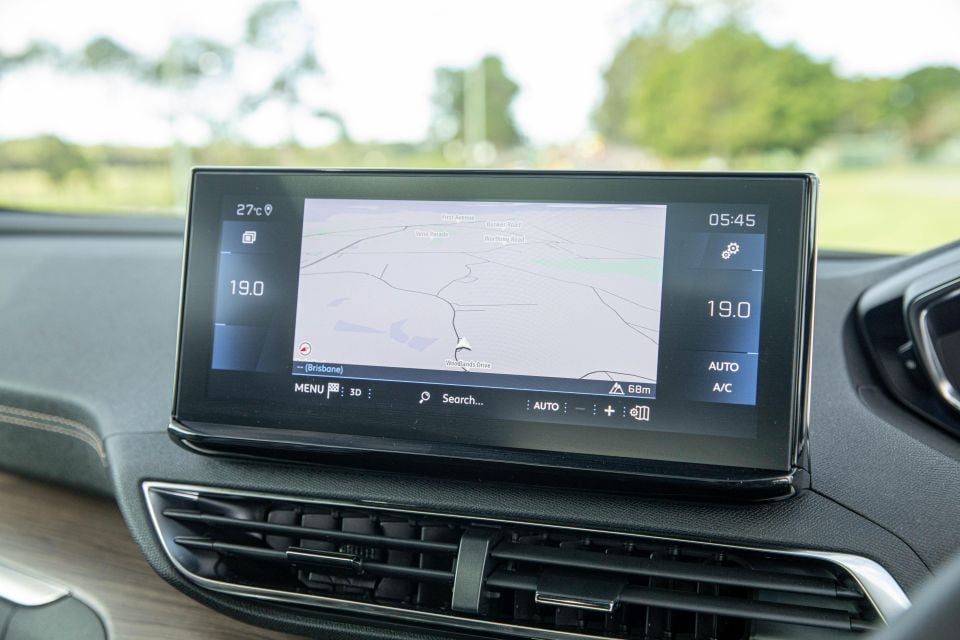
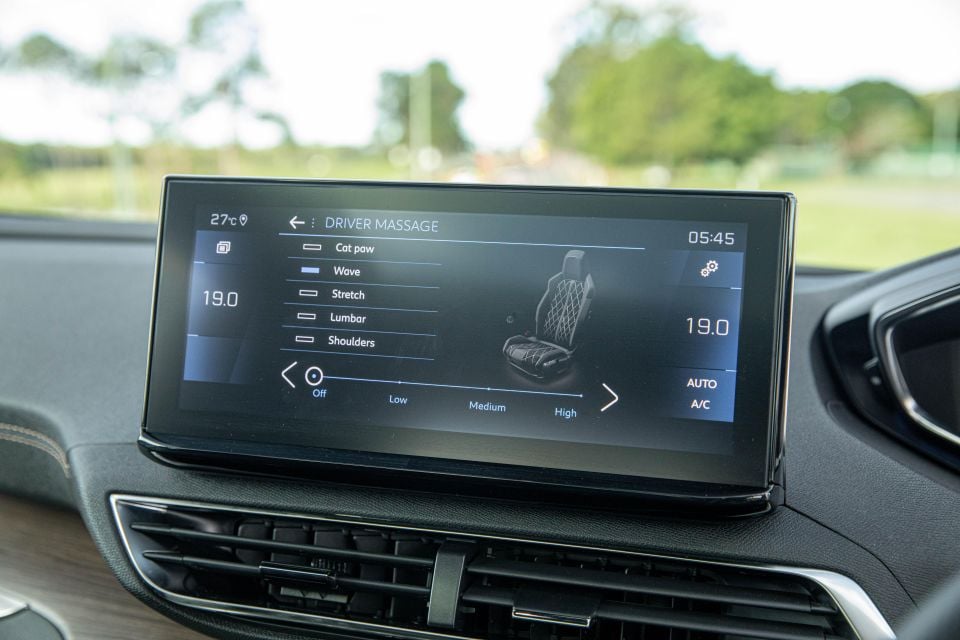
There’s also no physical button for the semi-autonomous parking assist system, which is instead confusingly buried in the vehicle touchscreen menu. Fortunately, once you find the function, it works splendidly.
The infotainment system and its various functions need some work. There are shortcut buttons on either side of every screen that take you to different options menus, which sounds helpful but simply means you have three possible options to press if you’re trying to adjust a vehicle setting.
The ‘surround-view’ camera is more or less useless, only depicting on the screen the ground you have already reversed over – it’s basically stitching together the rear-view camera’s vision rather than having cameras around the vehicle. The reversing camera also has frustratingly poor resolution for something costing over $50,000.
You can press a shortcut button on any screen to adjust the temperature and fan speed, but you can’t access the full suite of climate functions this way. For that, you’ll need to press the climate toggle switch on the centre stack.
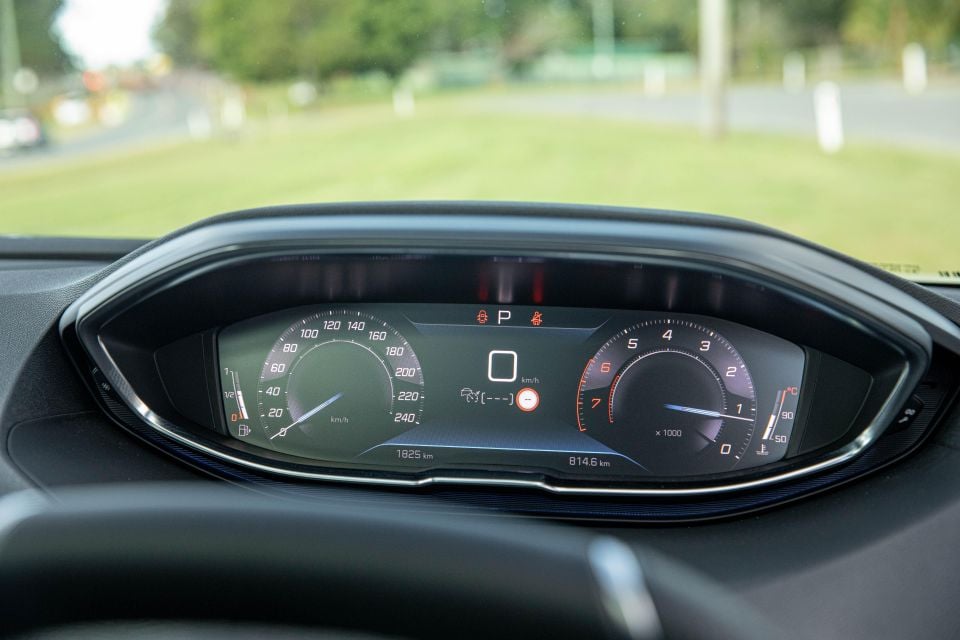
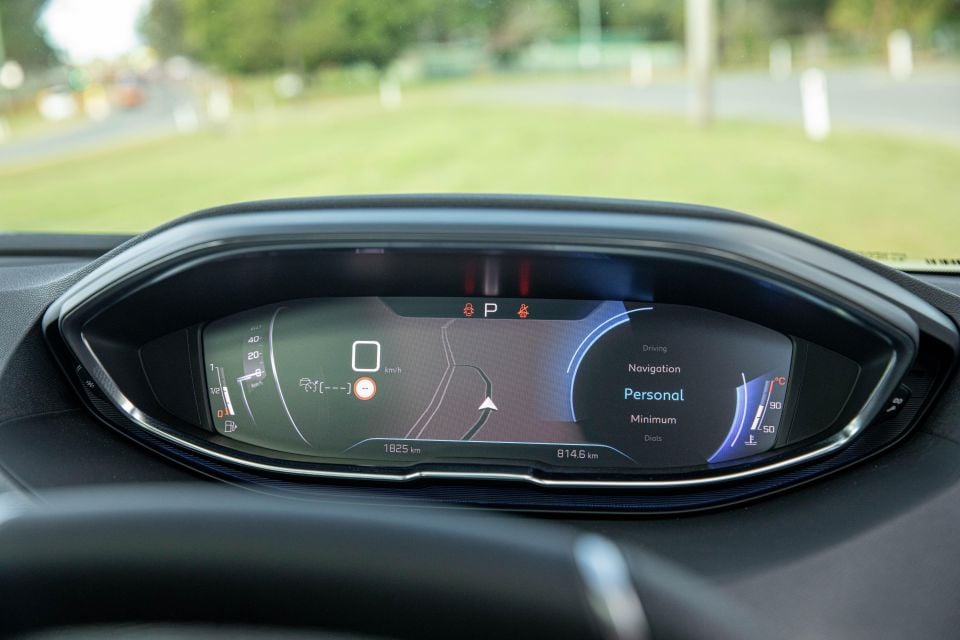
The digital instrument cluster is a much slicker bit of technology. Like the touchscreen, you can toggle between blue and copper colours, with the Sport drive mode turning the instruments red. The instruments are clear and easy to read thanks to a matte finish and you can choose between various layouts, including one with only the bare minimum information required.
There’s a navigation display for the instrument cluster, though it’s not anywhere near as detailed as, say, Audi’s Virtual Cockpit. Still, it’s handy and will also display turn-by-turn navigation instructions.
You can toggle between these screen layouts via a scroll wheel on the left side of the steering wheel, though confusingly the dial on the opposite side of the wheel is for skipping media tracks. There’s no volume wheel, with Peugeot instead providing two buttons on the left-hand side of the wheel to manage that.
On the wheel, you’ll also find a voice prompt button that did a pretty good job understanding our instructions, including inputting of addresses. Behind the wheel, you’ll find a cruise control stalk. While we eventually got used to it, it’s definitely an item you’ll need to take a good look at first before operating as it isn’t immediately intuitive.

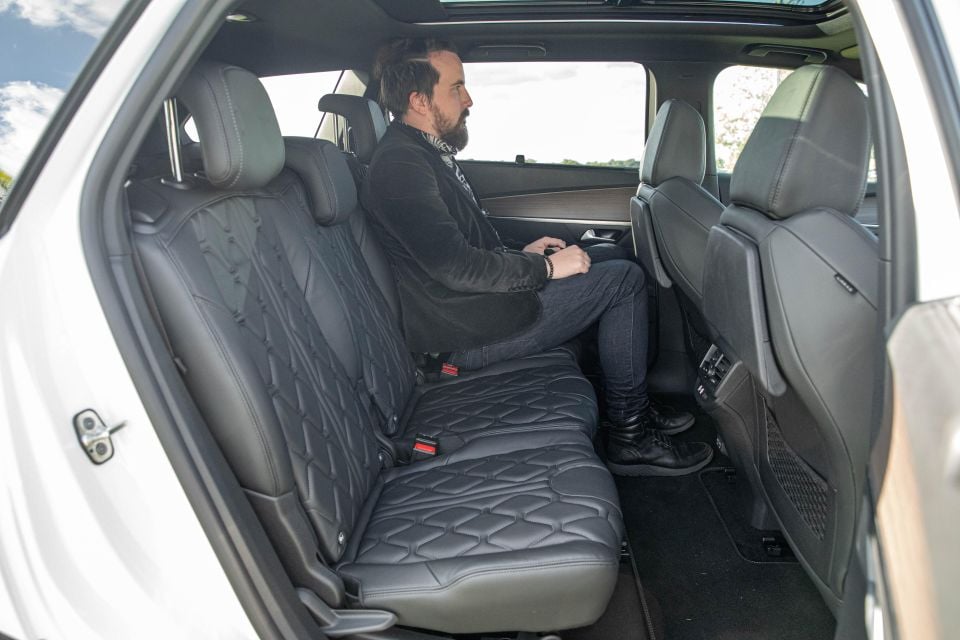
I was able to adjust the seat and steering wheel to my liking, with an unobstructed view of the instruments and my arm resting comfortably on the top of the door trim at traffic lights. The optional massaging driver’s seat further enhances comfort, offering five different styles with varying levels of intensity for each.
The panoramic sunroof further improves the cabin ambience but, unfortunately, function follows form. The sunroof severely eats into second-row headroom, particularly for outboard passengers. The roof drops down a bit on either side of the sunroof, which means passengers around 177cm or so tall will find their hair touching the roof.
The paucity of headroom is less pronounced in the centre seat but it still isn’t the most comfortable second-row. Best to skip the panoramic roof option, then.
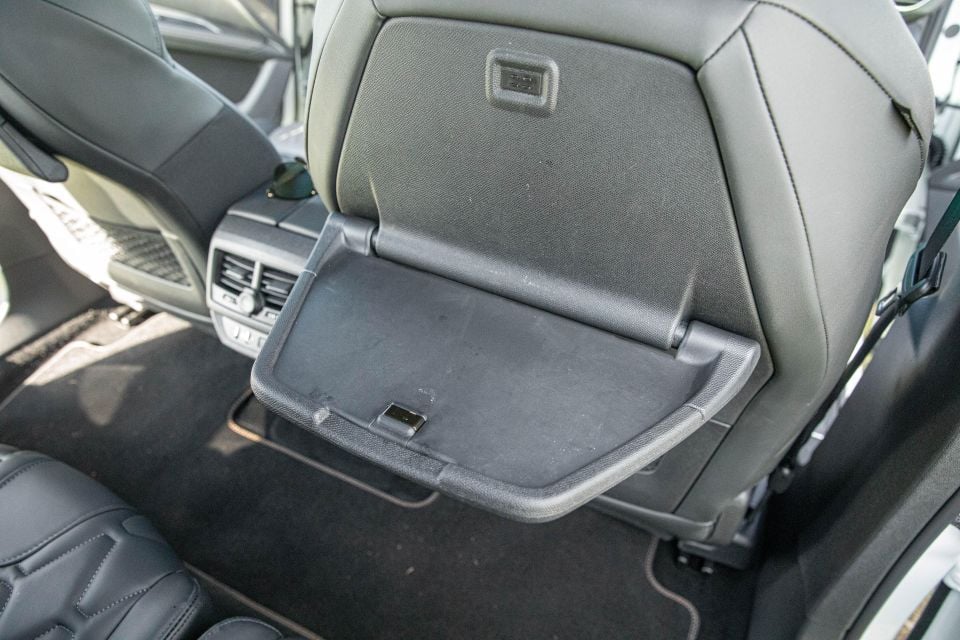
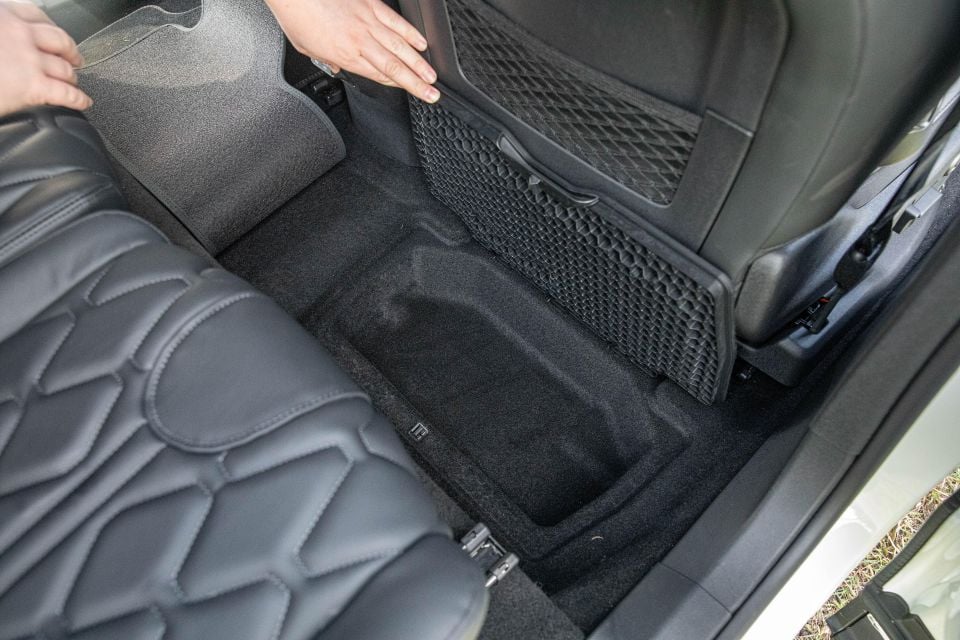
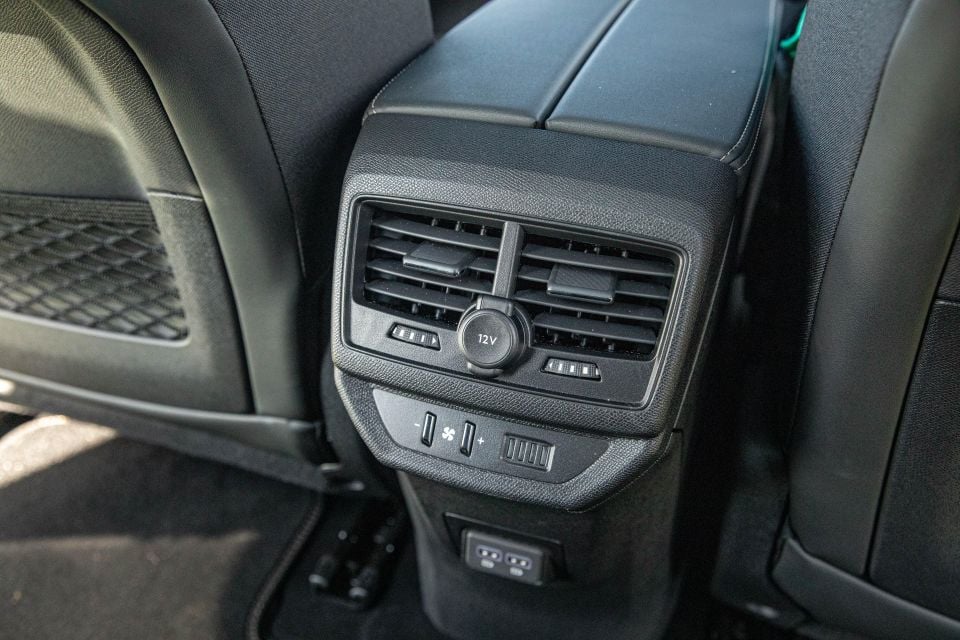
Each seat in the second row can be slid individually. There are also some clever amenities, like fold-down, airplane-style trays on the front seatbacks. Lift up the floor mat and you’ll find a storage cubby in the floor in front of each outboard seat – they’re a bit shallow, but they still prove to be handy for valuables stowage.
Second-row passengers can adjust the fan speed of the air vents mounted at the back of the centre console, while there’s also a 12V outlet and two USB-A outlets.
There are three top-tether and two outboard ISOFIX anchor points for child seats in the second row, though there’s no accommodation for child seats in the third row.

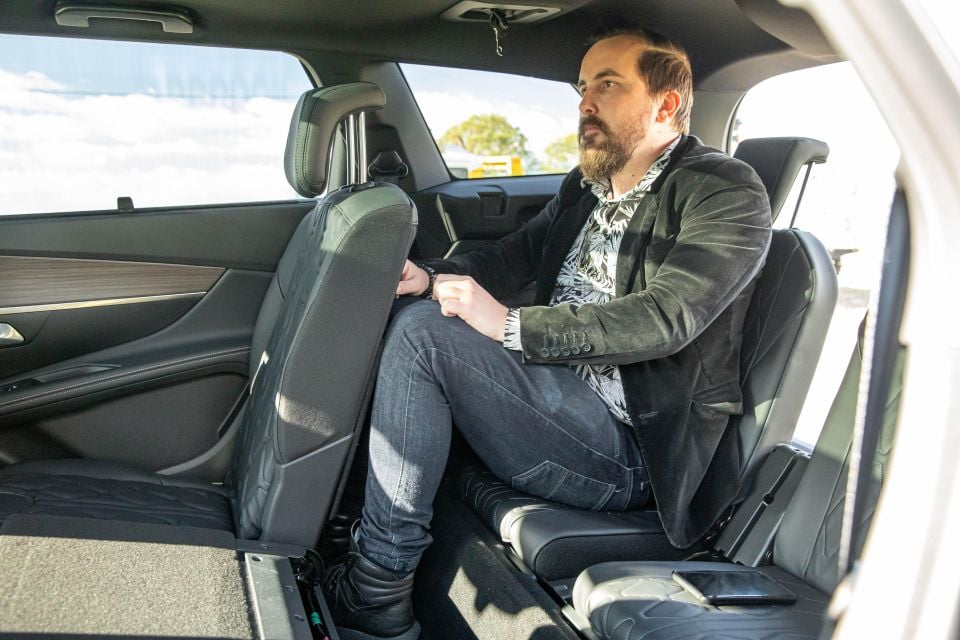
Where expert car reviews meet expert car buying – CarExpert gives you trusted advice, personalised service and real savings on your next new car.
The rear seats take a moment to figure out at first but are ultimately easy to fold. Lift the cover back, pull the strap. To pull them back up, lift the cover back, pull a strap and move a handle and they spring back up.
These are intended only for use by children old enough to not need a child seat, if not lanky teenagers. There’s not much in the way of amenities – a single, tiny cupholder, a 12V outlet, and that’s about it.
While the seats have the same upholstery as those in the first and second row, their small overall size gives them more of a jump seat appearance. But it is possible for an adult (or teen) to fit back here for short stints – headroom is decent and the second row slides back and forth to free up knee room, though you do sit with your knees in the air.
While there’s not much luggage space with all three rows up, the boxy profile of the 5008 aids practicality.

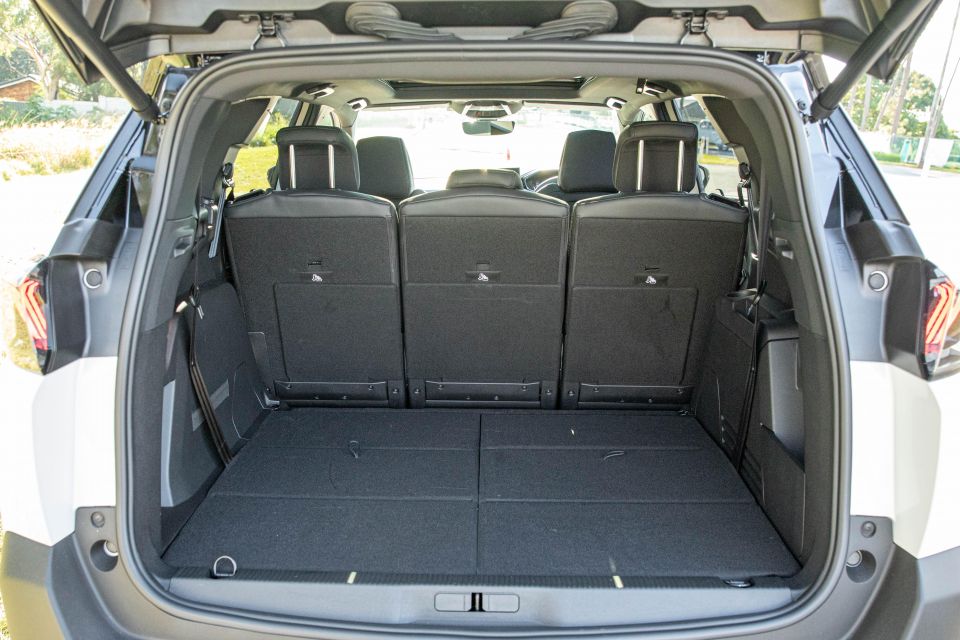
With all three rows up, there’s 166L up to the window line or 237L to the roof. Drop the third row and there’s 952L up to the window line, expanding to 1060L if you remove the third row seats entirely.
Finally, there’s 2042L up to the roof with the two rear rows folded, or 2150L with the second- and third-row seats removed entirely.
Our 5008 tester had a series of build issues. The driver’s-side rear door wouldn’t open from the outside, likely due to a child lock fault. The front passenger seat rattled in the same manner we experienced in the smaller 2008 in Brisbane, while the driver’s door had an intermittent rattle of its own. Over rough roads, the tailgate would also rattle.
Finally, the infotainment system completely froze one day and the hard buttons did nothing, which further highlights why all-digital climate controls are a foolish idea. We had to restart the car to get the system working again.
It’s worth noting an identically-specified 5008 we had in our Melbourne office had none of these issues.
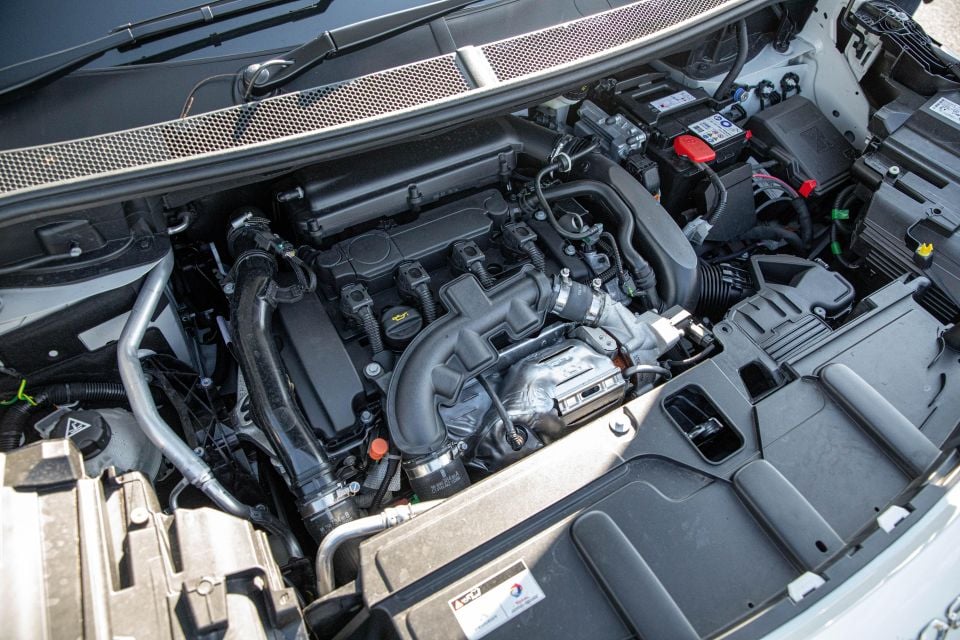
The GT petrol uses a turbocharged 1.6-litre four-cylinder engine producing 121kW of power and 240Nm of torque, mated to a six-speed automatic.
The GT diesel uses a 2.0-litre turbo-diesel four-cylinder with idle stop/start, an eight-speed automatic, and outputs of 131kW and 400Nm. Despite the extra punch, its 0-100km/h time is only slightly quicker at 10.2 seconds versus 10.5 seconds for the petrol.
There’s no option of all-wheel drive with either powertrain.
The GT petrol’s outputs are nothing to write home about. While the GT petrol is comparable to a Volkswagen Tiguan Allspace 110TSI (110kW/250Nm) and its torque outputs are close to a Mazda CX-8 Sport 2.5 (140kW/252Nm), the 5008 GT petrol is priced up against the likes of the petrol Tiguan Allspace 162TSI (162kW/350Nm), the diesel CX-8 Touring AWD (140kW/450Nm) and the petrol Skoda Kodiaq 132TSI (132kW/320Nm).
This is the flagship 5008 petrol engine. In other markets, there’s an even less powerful 96kW/230Nm 1.2-litre turbo three-cylinder available, plus a smaller 1.5-litre turbo-diesel.
The 3008 is picking up a pair of plug-in hybrid powertrains this year, one of which packs a hot hatch-like 221kW of power, but the 5008 isn’t in line to get these. That’s likely due to packaging constraints, with a third row of seating and a large battery pack both requiring a decent chunk of space in the rear floor.
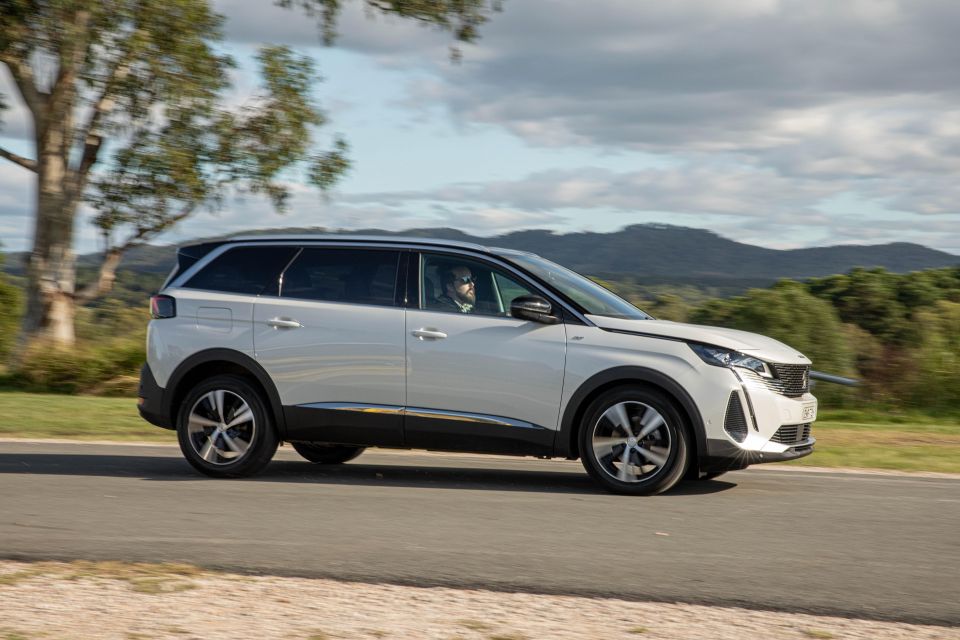
The 5008 GT is 83kg heavier than a comparable 3008 GT at 1473kg (tare) but the small boosted petrol engine doesn’t feel all that much more taxed.
However, though it may feel adequate with just one or two people in the car, a carload of seven people is going to tax this little engine. It gets a little breathless up hills, not helped by the six-speed automatic holding gears a touch too long on steep grades.
While it won’t perform miracles, Sport mode will quicken throttle response. However, it also dials up the noise and the soundtrack becomes very artificial and almost obnoxiously noisy.
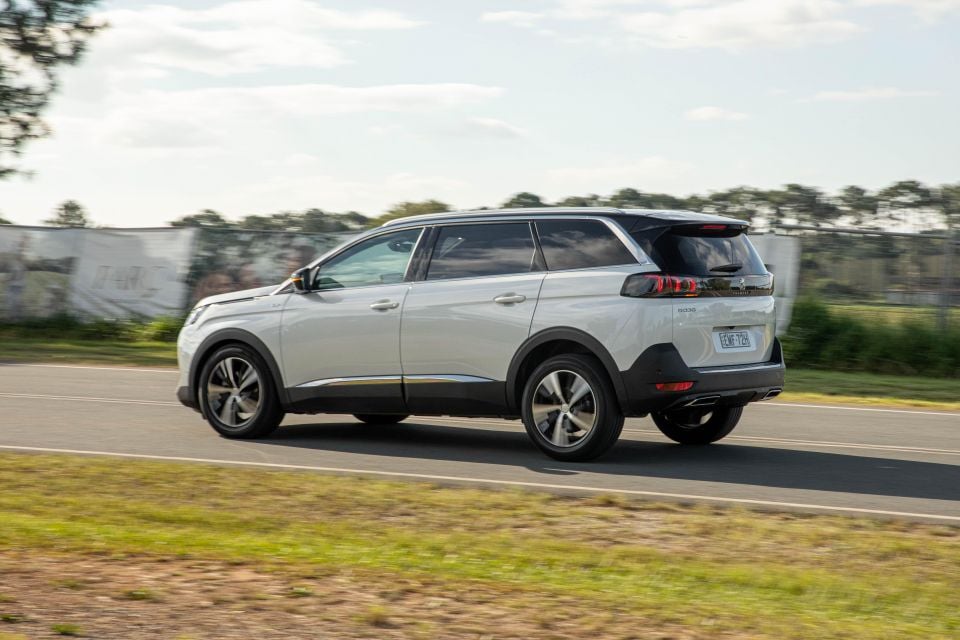
It mightn’t be the most powerful engine but at least it’s a willing unit, with smooth power delivery with a lighter foot and a pleasantly sporty note that isn’t overbearing in the default drive mode.
The six-speed automatic is well-matched for the most part. It’s never clunky, though occasionally a shift is more pronounced.
Like the 3008, the 5008 features a simpler twist-beam axle at the rear but there’s really no detriment to ride quality. The 5008 has a ride that’s a touch firm but soaks up bumps and ruts with ease and is always comfortable.
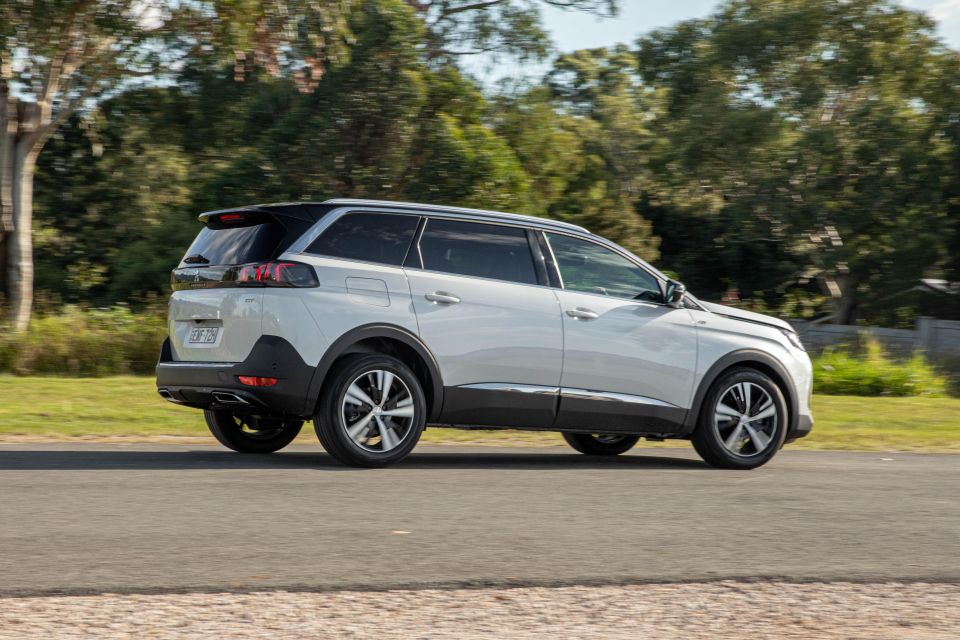
Handling is also praise-worthy. Body roll is well controlled in corners and the 5008 always feels planted, while its steering is pleasantly light which aids inner-city manoeuvrability.
At low speeds, the steering can virtually be controlled with a single finger, though it typically avoids that overly light, video game-like feeling you experience in, say, a Renault Koleos.
In all, the 5008 is a pleasant family SUV to drive, but just be mindful a full complement on board is going to cause its engine to strain a bit.
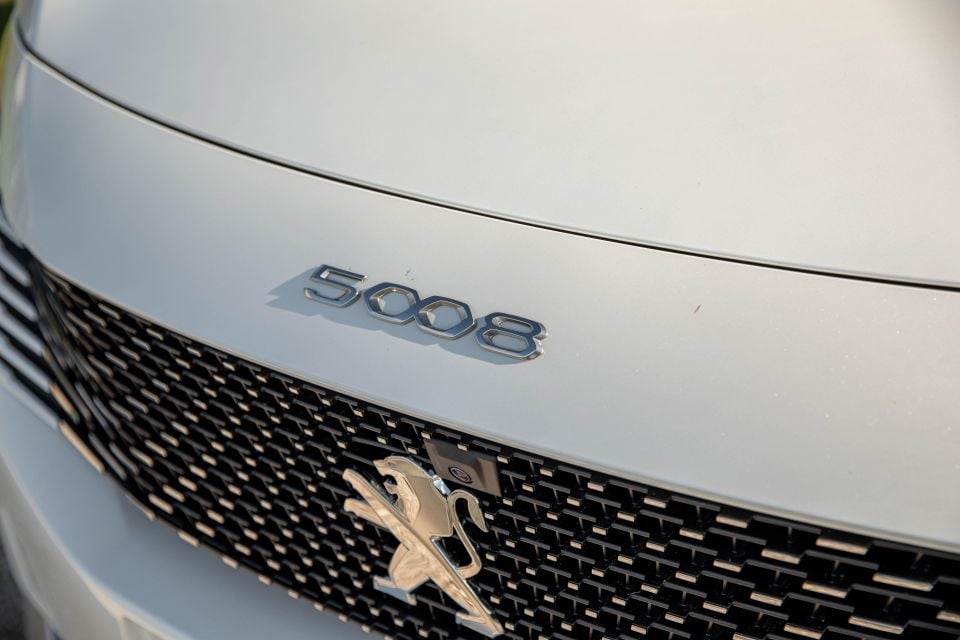
Peugeot claims a combined fuel economy of 7.0L/100km for the GT petrol. We averaged 8.0L/100km over a test loop comprising highways and inner-city and suburban roads, increasing to 8.7L/100km over the course of a week.
It requires 95RON premium unleaded fuel and has a 56L fuel tank.
Servicing is required every 12 months or 20,000km, whichever comes first. It’s backed by a five-year, unlimited-kilometre warranty, with Peugeot offering five years of capped-price servicing.
The first five services in the GT petrol cost $397, $793, $397, $806, and $410 for a total of $2803.
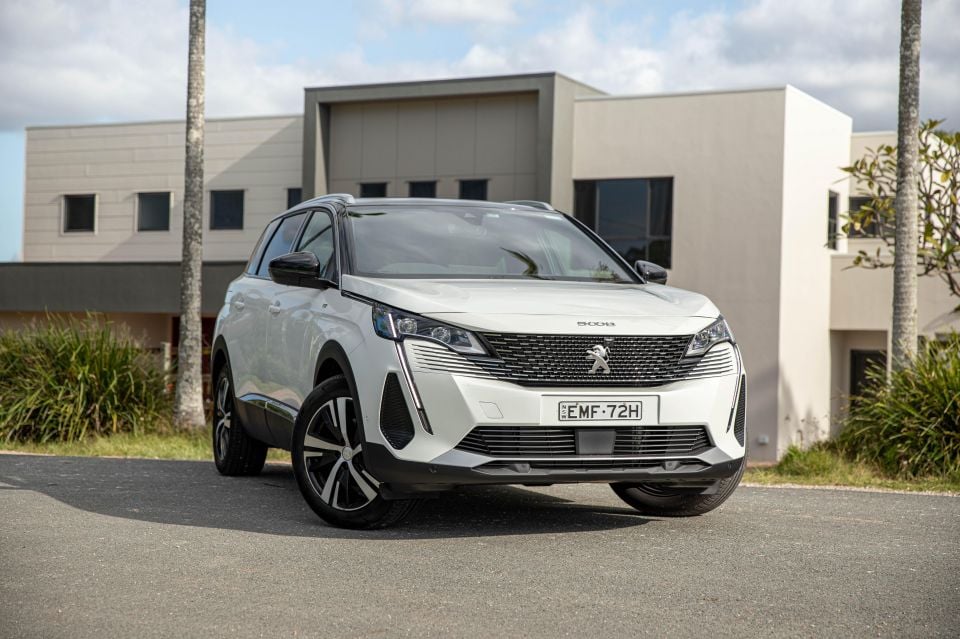
If you want the most stylish option in this segment, the Peugeot 5008 arguably takes the crown.
It may be bigger and boxier than a 3008 but it still has upscale, expressive styling inside and out.
Look a little deeper, though, and there are some flaws. The infotainment is disappointing, the panoramic sunroof cuts into second-row headroom in a way rival panoramic sunroofs don’t. And this powertrain, while pleasant, could do with some more punch, particularly if you’re hauling a carload of people.
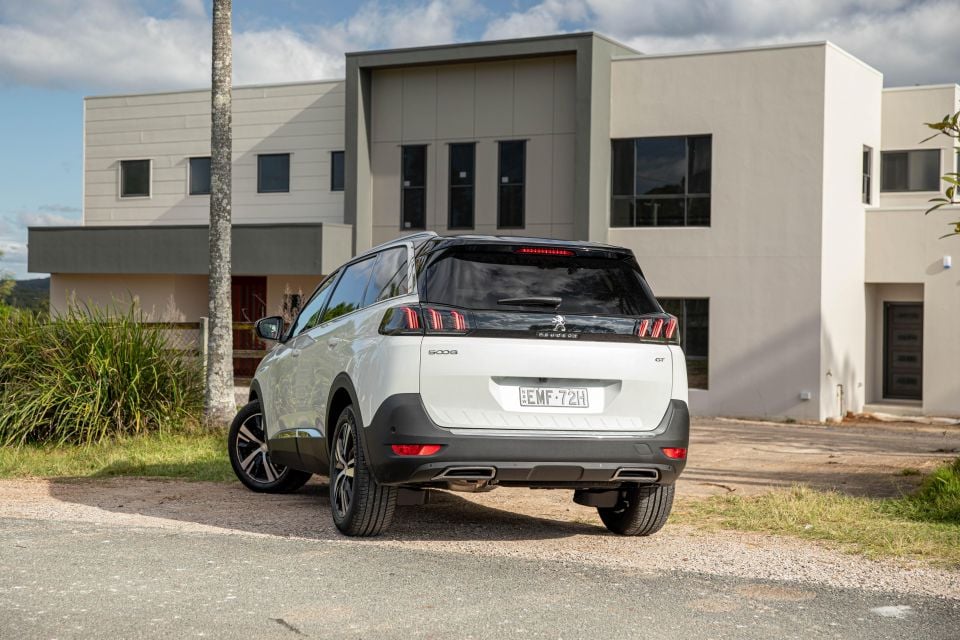
There’s also no getting around that, for something with no all-wheel drive and only adequate power and torque outputs, the 5008 is pricey. If you’re happy to forego some luxury items, you can get a larger, more powerful Hyundai Santa Fe or Kia Sorento for this kind of money.
In our review of the 3008 GT, we said, “With a little extra power or a little lower of a price, the 3008 could offer style and substance in equal measure.” Given the 5008 is essentially identical from the B-pillar forward, that same conclusion applies.
For some buyers, though, a smallish premium for this kind of European flair is worth it. And the 5008 certainly has European flair in spades.

Click the images for the full gallery
Where expert car reviews meet expert car buying – CarExpert gives you trusted advice, personalised service and real savings on your next new car.
William Stopford is an automotive journalist with a passion for mainstream cars, automotive history and overseas auto markets.


Ben Zachariah
2 Hours Ago
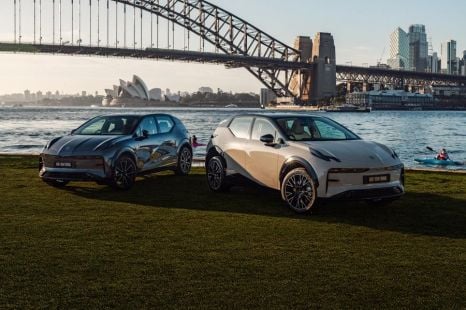

Max Davies
2 Hours Ago


Damion Smy
18 Hours Ago


Max Davies
2 Days Ago


James Wong
4 Days Ago
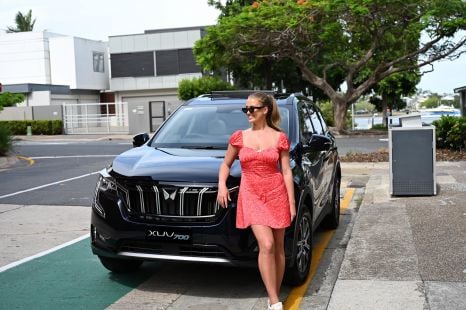

CarExpert.com.au
12 Days Ago